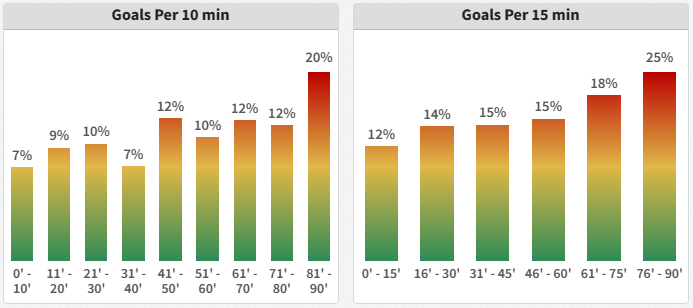I recently introduced a new strategy to the football trading membership program which targets goals in the last 15 minutes of matches.
The strategy which I refer to as L15 has performed very well so far and looks like it will be a profitable addition to our portfolio of strategies over time.
The question is, why target late goals when football trading, and how can you make consistent profits doing so?
In this article you will learn:-
- Why the last 15 minutes of football matches can be so lucrative
- The recent changes which will mean more goals being scored
- The advantages of trading the last 15 minutes
- How to find those late winners
- The best way of entering the market and trading late goals
Let’s take a look!
Why the last 15 minutes of a football match can be so lucrative
Below you can see a chart of goal distribution for the English Premier League (EPL) this season.

Source: Footystats
It’s clear that the window between 76’ and 90’ (far right) is a great time to find goals.
In fact, 25% of all goals this season have been scored during this timeframe, or 257 out of 1,013 goals.
If you’ve been football trading for a while, you will know that late goals are a common occurrence and often represent a great opportunity to profit with minimal risk.
Finding winning goals in injury time feels good for sure.
Matches are now seeing more injury time being played due to recent changes
Last season in the EPL, the ball was in play for just 55 minutes on average. This is something the Premier League wanted to address and as a result, all those breaks in play due to injuries, set pieces, and time-wasting are now being added on at the end of matches.
A good thing I would say. I personally hate seeing players sauntering off the pitch at a snail’s pace trying to run the clock down. Not now though, any such attempts will just mean additional extra time and potentially a lot more late goals being scored.
As a result of the changes, the ball is now in play on average for 58 minutes 37 seconds, compared to last season’s (2022/2023) 54 minutes 52 seconds. That doesn’t sound like a lot but over the course of the season that equates to another 24 extra matches being played in the Premier League!!
You can see in the table below how the number of goals per game has increased in relation to the average match time and the amount of time the ball is in play.

Source: The Premier League
What are the advantages of targeting late goals?
There are several reasons for targeting late goals.
- Low liability, maximum profit – Going for goals late on means you can quite often grab a very low price as the clock ticks down. This means your risk-to-reward ratio is tilted in your favour. 100%+ profit is easily achieved, sometimes much more.
- Saves time – Football trading can be time-consuming. By only targeting late goals, you only need to set aside 10 minutes or even less for each trade as you are not in the market for very long. Often, you don’t even need to do any pre-match research.
- More time to find winners – As pointed out further up, with the recent changes, the ball is now in play for longer with the additional time being added at the end. This means more time for teams to find those vital goals they are looking for.
How can you find late goals?
Pre-match selections
There are different ways of doing this. I send out my own pre-match selections via my membership program which are games that I have researched. These are typically teams that have a high percentage of late goals in their matches.
It is then a case of working out whether goals are likely during that 75-90’+ window or not.
In-play selection
You don’t have to pre-profile your matches though. You can just as easily monitor matches in-play and then research them once you feel one of the teams is chasing the game and goals look likely.
Prime matches are those where a stronger team is trailing and really must score. Other options are matches where a team that only has 10 players on the pitch is trailing. They will have no choice but to go for it which invariably leaves the backdoor open.
Other matches that are a good choice are those where a team needs to win to keep up their hopes of promotion, Euro places, or maybe even to avoid relegation.
I tend to leave matches where the goal margin is two or more goals. I prefer to see high urgency and motivation, and that one of the teams is busting a gut to get that equaliser. If in doubt, I will use half stakes.
What’s the best way of staking when trading late goals?
For me, the best approach is to drip your stakes in looking for those really late goals in injury time. If you keep laying at low odds, the risk-reward ratio is going to be hugely in your favour.
With many games now having a lot more injury time due to changes this season, late goals will happen even more.
TIP: If you can pre-empt the market and work out in advance of the injury time being announced how much there is, you can potentially get an even better price and get a jump on other traders. Once the market realises that there are 10 minutes of injury time and not 3 or 4, the price to lay will have drifted out as there is a lot more time left in the match to find another goal.
So there you go, just a few hints and tips on how to trade late goals in football matches.
Why not sign up for my membership program (Just £10 per month, cancel at any time) and start receiving all the best late goal L15 selections along with trading videos and other exclusive tips and content?
Thanks for reading.
Good luck with your trading. 😉



